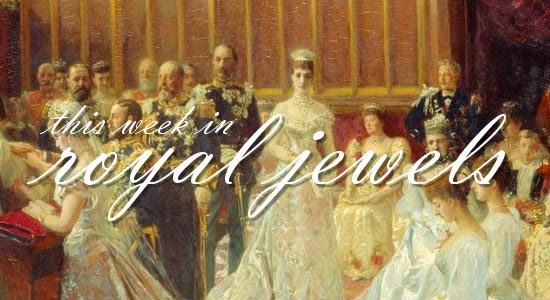During her lifetime, Princess Mary — daughter of George V and aunt of the current queen — had several tiaras at her disposal. One of the most often-discussed of these is Mary’s sapphire and diamond coronet (the one designed by Prince Albert for Queen Victoria), but today, let’s discuss a second: her convertible sapphire and diamond scroll tiara.
Mary wears the tiara, ca. 1922
When I use the word “convertible” to refer to a tiara, I generally mean
that it can be worn in more than one configuration. This tiara
qualifies, but not because it can be worn as a bracelet or a necklace;
instead, its central element can be swapped out to create a different
look. The diamond tiara, which features scroll and palmette motifs, can
be worn either with a vaguely floral, oval-shaped diamond element in its
center or with a large oval-shaped sapphire.
That large sapphire, which is surrounded by fourteen diamonds, was the princess’s wedding present from her mother, Queen Mary. Some have speculated that this is one of the Prince Albert sapphire brooches, though I’ve never seen any confirmation of that. The provenance of the diamond scroll tiara that Mary wore with her sapphire brooch is also uncertain. I’ve seen sources that assume that this piece was one of the jewels that George V gave his daughter as a wedding present (along with Queen Victoria’s sapphire and diamond coronet and the sapphire and diamond necklace, which also belonged to Victoria).
Mary wears the all-diamond version of the tiara, ca. 1920s
I’ve also seen speculation that the tiara may be Russian in origin. I’m actually going to posit another theory: I think the tiara might have been made by E. Wolff and Co., around the same time that the company made the Gloucester Honeysuckle Tiara for Queen Mary. The original version of the honeysuckle tiara shares some intriguing similarities with this one, including the ability to swap out the central element. I’ve got no solid proof of this, mind you — it’s just a hunch.
No speculation is needed regarding the fate of the tiara, however. Mary wore the piece at many important occasions during her lifetime, including the coronation of her niece in 1953. But after her death in 1965, the lion’s share of Mary’s jewels were sold, including the tiara, the sapphire and diamond necklace, and the brooch. (Not the sapphire and diamond coronet, though — that’s still with the Lascelles family today.) The tiara fetched almost ten thousand pounds at auction. The brooch, however, bested it, selling for a tidy £10,500.

